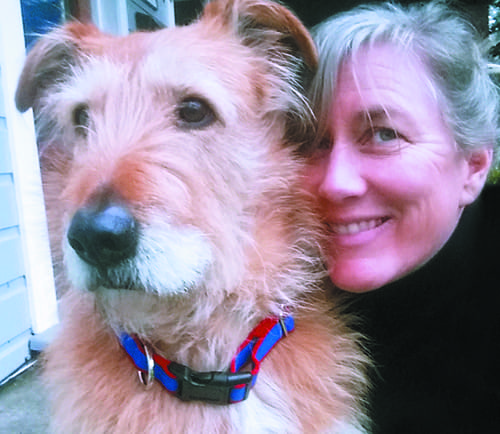In November, I went to a seminar about dog behavior and training and, for the first time in my life, brought a dog so I could participate in a “working dog” spot (take a turn having the instructor teach us something). The experience entailed two full days in the car and five nights in a hotel.
I have previously taken 4-year-old Woody for long road trips, camping trips, and to stay at friends’ houses. But he’s never stayed at a hotel before, and it presented him with a few new experiences. By and large, he was terrific: He was never tempted to pee on anything, he didn’t chew anything up or eat out of the trash, and he was happy to meet people who greeted him and calm about walking past people who didn’t. The most challenging thing for him at the hotel was hearing people walk down the hall past our room at night and not growling or barking; he seemed to be anxious about the strangers he could hear and smell but not see.
To make sure my large, block-headed dog felt as relaxed and happy as possible about the whole experience – so that he looked obviously friendly – I had a treat pouch with me at all times, so I could mark and reinforce all of his good behavior. I also looked for spots in the hotel where we could get a little distance from the things that made him nervous and deliver enough treats to help change how he regarded the stimuli. At one point, for example, I wedged our hotel room door open, so he could see people walk by the open door; every time we heard a person coming or saw people walk by, I started delivering treats; when the people were out of view (or earshot), the treats stopped. After only a few passersby, he was looking to me eagerly when he heard or saw someone.
Anyway, I was thinking about the work I did with Woody when I was recently at an airport for holiday travel. I stepped out of a long line for coffee because I was actually afraid of a dog who was accompanying a man in line in front of me – a big, muscular, intact male dog with “fighting cropped” ears and wearing a choke chain. The dog looked uneasy and overstimulated (tightly tucked tail, panting, ears pinned back) and his owner was not only oblivious to the dog’s discomfort, he also was completely distracted with his coffee order and seemed unconcerned about the apprehensive looks that people near him were casting at him and his anxious dog. In my opinion, subjecting an unhabituated dog to such stress is not fair to your fellow travellers – and certainly not fair to the dog.
It’s a lot of work to habituate your dog to new experiences, but it is a critical responsibility if you are going to subject other people to them; no one should have to be afraid of your dog in public.







I’m a long-time, loyal subscriber who has recommended your publication to many people. It’s full of valuable information and I look forward to every issue. I read your recent editorial and would gently suggest that you consider whether “fighting cropped” is the best term to use in describing a dog’s cropped ears. While I personally would never cut off part of a dog’s body for fashion and hope for a day when cropping is illegal, quite a few American breed standards allow or require cropped ears (Dobermans, Schnauzers, AmStaffs, and more). The crop you describe is fairly common in several breeds, and does not mean that the dog is intended for the horrors of dog fighting. Like you, I would have been extremely concerned about the dog’s body language, as well as his intact status, the choke chain, and especially the owner’s inattention. Those are far more reliable indicators of potential danger than his appearance. I adopted a dog last year who probably looks just like the dog you describe, with ears cropped very short. The animal control officer was desperate to find him a home because his temperament was so outstanding (even in the stressful and chaotic environment of a kill shelter), but people only saw his appearance, especially the ears, and no one would adopt him. He is a wonderful, gentle soul and a perfect gentleman to all living things – the absolute antithesis of a fighting dog. I hope that if you saw my well-behaved dog, with his excellent social skills and “fighting cropped” ears, you would look past his appearance. A term like “fighting cropped” fuels the fires of ignorance and fear that cost thousands of dogs their lives, regardless of their temperaments. I’m sure we both agree that the best indicator of a dog’s temperament is his behavior, not his appearance. Thank you!